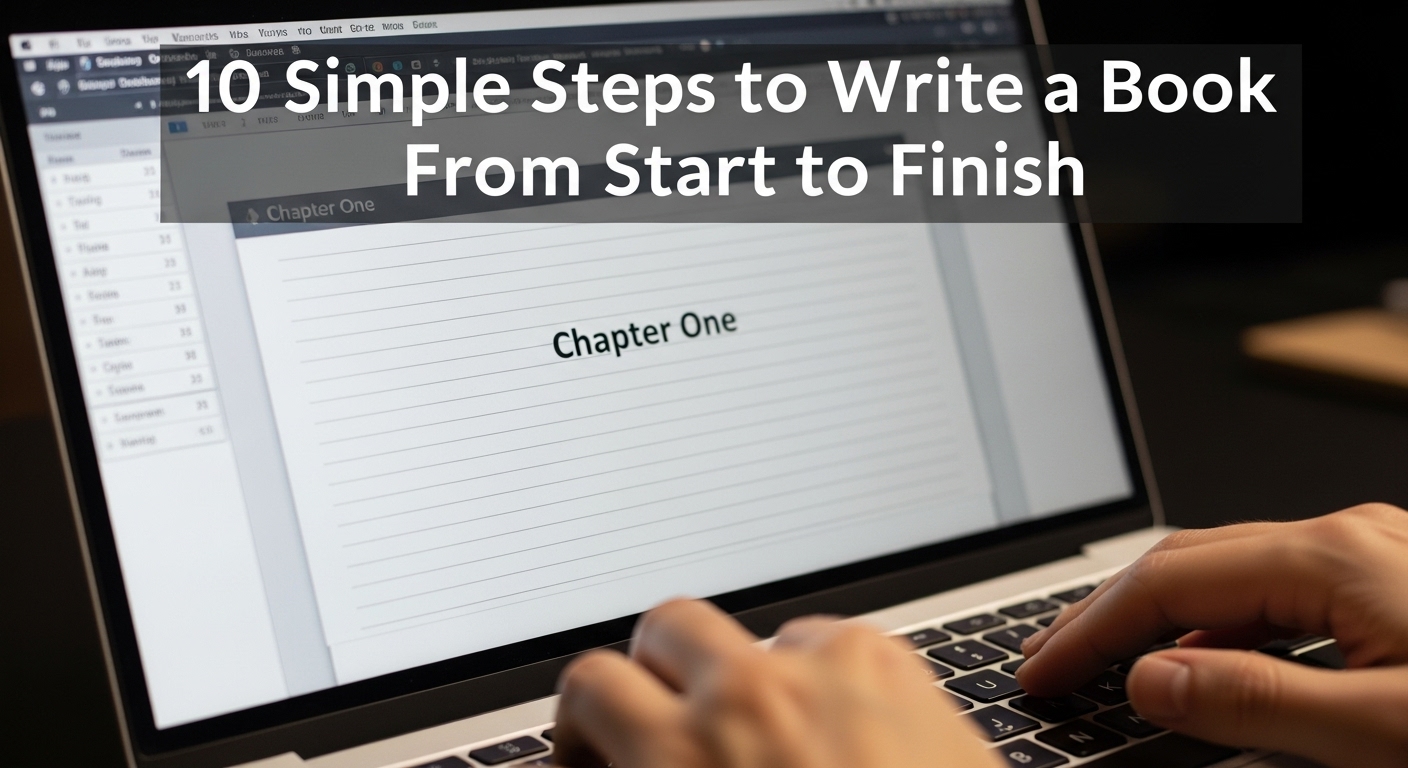
Writing a book is an extraordinary journey—one that blends imagination, discipline, and passion. Whether you’re crafting a novel, sharing a personal memoir, or creating a business guide, the process can feel overwhelming without a plan. Fortunately, breaking it into clear, manageable steps makes it far less intimidating. In this article, we explore 10 simple steps to take your book from a blank page to a finished manuscript—while also pointing out when professional writing and editing support can strengthen your work.
Table of Contents
ToggleStep-by-Step Blueprint to Bring Your Book to Life
Before diving in, it’s important to understand that writing a book isn’t just about inspiration. It’s a combination of planning, discipline, creativity, and refinement. These steps are designed to make your writing journey smoother and help you avoid common pitfalls—whether you’re doing it alone or with the help of professional writing and editing services.
1. Define Your Purpose and Know Your Audience
The very first step in writing your book is understanding why you want to write it and who you’re writing for. These two elements will shape your book’s tone, content, and structure.
Are you aiming to teach something new, explore a personal journey, or entertain readers with fiction? Knowing your objective gives your writing clarity. Similarly, understanding your ideal reader—age, interests, and needs—will help guide your storytelling, voice, and even chapter length.
At this stage, consulting a writing coach or book strategist can help you define a mission statement for your book and solidify its direction.
2. Choose and Refine Your Core Idea
Every book starts with a central idea. Take time to explore it deeply. A strong concept should be clear, focused, and meaningful. Whether it’s “how to start a small business,” or “a young girl uncovers her family’s hidden legacy,” your idea should be compelling enough to sustain an entire book.
Ask yourself: Is the idea broad enough for 200+ pages? Does it have depth, conflict, or insight? You can use mind maps, freewriting exercises, or brainstorming sessions to stretch the idea into themes or subplots. Professional developmental editors can help test the viability of your concept and provide early feedback on direction and market fit.
3. Create a Working Title and Build an Outline
A working title gives your book focus, even if it changes later. More importantly, a structured outline prevents you from writing aimlessly. It keeps you aligned with your goals and ensures logical flow.
Fiction writers might use the three-act structure or the hero’s journey, while nonfiction writers can organize content into lessons, principles, or chronological chapters. Even a simple bullet-point roadmap works wonders.
Outlining doesn’t mean you’re stuck—it provides a skeleton that evolves. Writers often collaborate with planning specialists or book architects to create an effective and customized outline.
4. Set a Writing Schedule and Stick to It
A book won’t write itself. Consistency, not inspiration, is what gets the job done. Set daily or weekly writing goals that fit into your lifestyle. Whether it’s 300 or 1,000 words a day, the key is to make writing a habit.
Use tools like calendars, alarms, or writing apps to track progress. You might find that early mornings, lunch breaks, or quiet weekends are your most productive times. Remember to be flexible but firm with yourself.
If you struggle with accountability, many writers work with writing coaches or editors who provide regular check-ins, critique, and encouragement to keep the momentum alive.
5. Write the First Draft Without Self-Criticism
The first draft is for your eyes only. Don’t worry about grammar, perfect sentence structure, or even logic. Your goal is to transfer the ideas from your head onto the page without filtering them.
Expect your first draft to be messy—it’s part of the process. This stage is about momentum, not mastery. Keep writing forward instead of going back to perfect chapters too early.
For those who feel stuck, hiring a ghostwriter or using writing services to develop rough transcripts into draft chapters can be a good option, especially for nonfiction or memoirs based on interviews or journals.
6. Step Away and Reflect
Once the draft is finished, resist the urge to start editing right away. Let it breathe. Taking a break—anywhere from a few days to a couple of weeks—creates the emotional distance needed to review your work objectively.
During this rest period, jot down thoughts about the experience. What came out better than expected? What felt forced or unclear? Some writers use this time to share early drafts with trusted beta readers or receive a manuscript evaluation from an editor.
Such feedback at this stage can offer powerful insight into what’s working and what’s not—before diving into revisions.
7. Revise With Purpose
Rewriting is where the real writing begins. Revisions go beyond grammar—they focus on enhancing the message, improving structure, refining pacing, and deepening character development or theme clarity.
Start with the big picture: Does your content deliver on the original promise? Are your chapters in the right order? Do you need to cut repetitive sections or expand underdeveloped points?
Most authors go through two to three major revisions. A developmental or content editor can be immensely helpful here. They challenge you to think critically and restructure if needed while keeping your voice intact.
8. Polish Your Language Through Copyediting
Once you’re confident in the structure, it’s time to focus on clarity and consistency. Copyediting looks at:
- Sentence structure
- Word choice
- Grammar and punctuation
- Tone and continuity
- Overused phrases or passive voice
Even strong writers miss things. At this point, hiring a professional copy editor is a wise investment. They not only catch errors but also tighten prose and smooth transitions—improving your book’s overall readability.
Some editing services bundle content and copyediting for seamless transitions from big-picture revision to sentence-level finesse.
9. Proofread for Perfection
Proofreading is your final quality check before publishing. While it may seem minor, it’s absolutely essential. It involves spotting:
- Typos
- Punctuation mistakes
- Formatting inconsistencies
- Spelling errors
- Missing words or numbers
A proofreader ensures your book is clean, professional, and publication-ready. Don’t rely on spell-check alone—human eyes are crucial at this stage.
Writers often enlist independent proofreaders separate from their primary editors to bring in a fresh perspective. This step safeguards your credibility and reader trust.
10. Prepare for Publishing or Submission
With your manuscript complete, it’s time to launch it into the world. You have two main routes: traditional publishing or self-publishing.
For self-publishing, you’ll need:
- ISBN and copyright registration
- Interior formatting (PDF for print, ePub for digital)
- A professionally designed cover
- Back cover copy and metadata
For traditional publishing, you’ll need:
- A compelling query letter
- A polished book proposal (for nonfiction)
- A concise synopsis (for fiction)
- A list of agents or publishers that fit your genre
Many authors work with publishing consultants or hybrid publishing services to navigate this complex process. Don’t rush. Give your book the attention it deserves so it reaches the right hands—and hearts.
Final Thoughts
Writing a book from start to finish is a fulfilling creative endeavor—but it requires discipline, structure, and often outside support. By following these 10 simple steps, you can transform a vague idea into a fully formed manuscript ready for readers. And when you incorporate expert help—from editors to formatters to writing coaches—you ensure your final product is polished, professional, and powerful.
Stay committed, trust the process, and don’t be afraid to ask for help. Your story is worth telling—and someone out there is waiting to read it.
FAQs
Q1: How long does it take to write a book?
A: On average, 6 to 12 months for a first draft, though timelines vary depending on word count and writing pace.
Q2: Do I need professional editing?
A: Yes. Even experienced authors benefit from professional editing to ensure clarity, structure, and polish.
Q3: Is it necessary to outline before writing?
A: No, but it helps tremendously. Outlining provides structure and reduces the chance of writer’s block.
Q4: What is the difference between copyediting and proofreading?
A: Copyediting focuses on sentence clarity and grammar, while proofreading checks final errors before publishing.
Q5: Should I hire a ghostwriter?
A: If you have strong ideas but limited time or writing ability, a ghostwriter can bring your story to life authentically





